The importance of SEO for financial services can’t be emphasised enough. As a key element of any digital marketing strategy, SEO is the engine that powers the finance and banking industries. It ensures that potential customers who are searching online are attracted to their websites.
SEO for financial services is a digital marketing strategy designed to help companies in the financial sector optimise their websites. The goal is to improve search engine rankings, which in turn leads to increased traffic and conversions.
Let’s dive deeper by exploring more details. Use this post as a guide to enhance the SEO of your financial services in an ever-evolving online landscape.
What Is SEO for Financial Services?
Understanding SEO may seem daunting at first, but it’s crucial for enhancing your website’s performance in search engines. Let’s begin by defining what a search engine is. Think of Google or Bing; these platforms are the go-to places for people seeking answers online.
Many people turn to the internet when they need financial help or have questions. That’s why having a clear, informative website is essential. Doing so makes it easier for people to find you when they’re searching for solutions.
As a result, your online visibility will increase, attracting more potential clients while meeting the specific needs of your target audience.
Remember the following for optimal internet ranking:
- Offer Worthwhile Organic Search Content: Your website gains credibility when you produce content that responds to the issues and inquiries your target audience is looking for. By doing this, you not only demonstrate your expertise but also increase the likelihood that you will appear in search results when users enter relevant keywords.
- Ensure the Safety and Health of Your Website: The user experience is improved by a well-running website with a user-friendly interface, quick load speeds, and mobile responsiveness. Maintaining security measures like SSL certificates and malware protection also fosters trust among visitors and search engines, which improves search rankings.
- Obtain Beneficial Backlinks From Authoritative Websites: Backlinks serve as the equivalent of endorsements from other websites. Links from trustworthy and pertinent websites show search engines that your website is valuable and trustworthy. Your website’s trustworthiness and search engine rankings can be significantly improved by acquiring backlinks from reliable sources.
Remember that each of these elements works together to create a solid SEO plan that will increase organic traffic to your website and improve its visibility.
Hire an SEO agency that specialises in optimising financial services websites to improve their search engine rankings.
What are the SEO Pain Points in the Financial Services Industry?
Extremely Competitive Environment
Competition in the corporate world is fierce right now. The challenge of standing out has only intensified as larger companies continue to grow exponentially. Add to that an influx of new competitors, making the task of boosting your organic visibility even harder.
Given these conditions, it’s now crucial to have a content strategy that focuses on a clearly defined target audience. It’s not just a suggestion anymore; to succeed in this competitive landscape, you must tailor your content specifically to meet the unique needs and preferences of your audience.
Complex Subject Matters
The financial services and fintech sectors are steadily growing, and as more startups and software providers enter the scene, the market is becoming increasingly saturated.
To stand out in this competitive landscape, delivering high-quality content consistently is key. Your material should cater to your audience’s specific needs at every step of the way.
Using a range of SEO tactics is essential if you want to stand out effectively. These consist of:
- Analyze Content Strategy Search Results: Look closely at the kind of content that is currently available and doing well in search results. You can adjust your content by using this data to determine popular subjects with your target audience.
- Use the Main Keyword in the URL: When creating the URL for your content, make sure to include the primary keyword you’re aiming for. In addition to improving user experience and intuitiveness for your audience, this also aids search engines in comprehending your website’s subject.
- Optimise Your Title and Meta Description: These two elements act as a sneak preview of the information that is contained in your content. Create a catchy title that appropriately summarises the content of your post and contains your major keyword. The value of the material should be briefly described in the meta description to entice people to click through.
- Use Keywords in Headings and Text: Your post’s primary text body and headings should naturally contain your goal keywords to help search engines understand what your content is about. But stay away from keyword stuffing; put readability and consistency first.
- Add Alt Text to Images: Alt text, sometimes called alternative text, is a succinct description of the images that are used on your website. Improved accessibility for those with vision impairments is achieved by including pertinent alt text, which also gives search engines additional information about your material.
- Make Your Wording Precise and Concise: To help readers navigate the text, divide long paragraphs into smaller ones, use bullet points when necessary, and take into account using subheadings. An engaging format that is easy to read enhances user experience.
- Link to Other Content on Your Website: Internal linking helps make the connections between the various sections of your website sensible. Visitors can browse related topics, and it communicates to search engines the organisation and hierarchy of your information.
- Connect New Page to Relevant Existing Pages: When publishing new content, if your website already contains any pages that are pertinent to the subject, link to those pages. Interlinking facilitates user navigation and distributes SEO value across your website.
Navigating these strategies is crucial for standing out in today’s crowded fintech and financial services market and attracting the right audience to your content. In such a competitive field, having a team member skilled in SEO for financial services or partnering with a company that specialises in SEO-focused content creation—can be a huge advantage.
Utilising SEO to Increase Lead Generation
Without a doubt, integrating SEO into your marketing strategy will help you attract vital B2B leads. Just look around and you’ll see an increasing number of financial organisations leveraging SEO to their advantage.
This means that competition for your business is heating up. As more finance companies embrace SEO, the pressure is on for everyone to step up their efforts. Climbing to a high position in search results has shifted from being a nice-to-have to a must-have. Why? Because it helps you stand out from competitors and attract customers actively seeking your services.
In short, investing in SEO is not just an option; it’s a strategic necessity that should not be overlooked if you aim to expand your client base and secure a steady flow of B2B leads.
Improved Content Quality
When we discuss the significance of information related to financial services, we’re essentially talking about its potential impact on people’s lives, affecting their financial status, well-being, safety, and happiness. This is why the term ‘Your Money or Your Life’ (YMYL) often comes up in conversations about financial matters, underscoring the importance of this information for people’s well-being.
Choosing the wrong health insurance due to misleading information can have more serious consequences than, say, picking the wrong coffee maker. A mistake with health insurance could lead to significant financial losses and even adversely affect your physical health, while choosing the wrong coffee maker is merely inconvenient. This highlights the importance for financial service organisations to be cautious in creating accurate and accessible content.
Google recognizes this importance, rigorously evaluating and ranking pages with YMYL content in its search results. Only the most reliable, relevant, and high-quality content appears at the top, ensuring the availability of accurate information, especially on topics that significantly impact daily life.
Content in the financial services sector spans a wide array of topics including happiness, safety, health, and well-being. Companies in this field must produce accurate content to avoid the severe consequences of disseminating misinformation. Google is attuned to this need, scrutinising YMYL content to present consumers with the most reliable information available.
Consequences of Limited Internal Resources
Financial institutions like banks and investment firms often face challenges due to limited resources. These limitations could stem from a lack of funds, outdated technology, or insufficient staffing to meet demands.
The costs can escalate quickly for small businesses trying to market themselves and boost their online presence, particularly if they aim to engage customers across multiple channels.
Ideally, these businesses should have a skilled team equipped with all the necessary SEO tools to excel in their roles.
When that’s not feasible, bringing in a marketing or SEO agency can be a smart alternative. Such agencies boast teams of experts well-versed in their fields and have access to state-of-the-art tools. Typically, the cost of these specialised tools is too steep for an individual business to bear on its own.
Also Read: How Long Does SEO Take to Update After I Changed Something on My Site?
Here Are Some of the Key Benefits of SEO for Financial Services
Increased Brand Recognition
Imagine this scenario: Your brand consistently appears in search results whenever people look for information related to your industry or the products and services you offer. The result? Increased trust and undeniable brand recognition from those individuals.
To achieve this, you should create exceptional content for your website and social media platforms. Tackle the concerns of your audience through blogs, videos, and posts that offer practical solutions. This approach shows genuine care beyond just making a sale, fostering trust and building a uniquely strong and meaningful relationship.
Better User Experience
How users interact with your website is greatly influenced by how readily it can be found on search engines. Additionally, making sure that your financial services website is user-friendly is crucial for drawing in and keeping visitors.
Therefore, it’s crucial that your website adheres to the following standards:
- Easy Navigation: Ensure that navigating your website is a breeze. Users should be able to navigate the system and find what they’re looking for.
- Information That Is Concise, Transparent, and Directly Related to Your Financial Services Should Be Available on Your Website: This fosters trust and aids in visitor understanding of your offerings.
- Functional Across All Devices: Your website should operate smoothly and offer a consistent user experience whether visitors access it from a desktop, tablet, or smartphone. This ensures that users can comfortably browse your website regardless of how they reach it.
Remember that a well-optimised website improves user experience overall and promotes exposure, both of which are essential for the success of your financial services company.
Increased Website Organic Traffic
Using finance SEO techniques will boost your website’s visibility in search results. As you become more visible, more people will become aware of your offerings and are likely to visit your website. By consistently applying these strategies over time, you’ll see a gradual yet significant increase in overall website traffic.
Higher Conversion Rate
You have a better chance of turning website visitors into customers if you have more visitors. Instead of depending entirely on paid marketing, SEO efficiently achieves this goal by drawing in customers who are already highly interested.
Key SEO Tactics for Financial Services

SEO Strategies for Financial Services
In continuing strategy, an SEO campaign is about getting your website to appear higher on those search engine result pages. An SEO campaign isn’t simply a one-time activity. You want to ensure that people can find your website thoroughly, attract more visitors naturally, and ultimately increase your revenue.
Consider this: various business kinds require multiple strategies. Consider fintech firms as an example. Because their fintech SEO strategy must be distinct from what financial advisors employ, they cannot simply follow a generic plan.
As you can see, the fintech sector is quite distinctive. It’s all about cutting-edge technology, and it has a target market that it wants to get in front of. So, to do it correctly, you need an SEO strategy specifically designed for this unique circumstance. Keep these suggestions in mind as you create your campaigns.
Analyse Your SEO Current Status
Begin by thoroughly assessing your website’s current SEO standing. This understanding is crucial as it provides the foundation for identifying areas that need improvement, spotting new opportunities, and gaining deeper insights. You have two options: either manually review your website’s SEO performance or use an SEO checker tool for a more rapid assessment.
By evaluating your existing SEO status, you’ll be better equipped to enhance your website’s visibility and effectiveness in search engines. This step lays the foundation for improving your online presence and drawing in more potential customers.
Evaluate Content
A thorough examination of your site’s content is required as the very first step. Your critical YMYL pages deserve your undivided attention. It is now essential that you adopt a proactive stance by responding to the following questions:
- Are your YMYL pages comprehensive and beneficial?
- Is your information current with laws and regulations in effect today?
- Is your audience able to quickly and effectively skim your content?
- Is it simple to read and comprehend for your target audience?
- Do they have intriguing meta descriptions and titles?
- Does your website and content strategy contain any duplicate content?
A simple approach to improving your website’s ranking is by fixing existing content.
Perform Keyword Research
After enhancing your existing pages, the next step is to conduct keyword research to identify new content opportunities. Look for topics and keywords that people are actively searching for, especially those related to your core financial services. Understanding the intent behind these search terms is essential, as it will inform both your SEO strategy and your content planning.
Competitor Analysis
Understanding who your primary organic competitors are is crucial. They may not always be the obvious competitors in your industry. Once you’ve compiled your list of competitors, take the time to examine their content. This can offer valuable inspiration and highlight areas where you could fill gaps. It’s akin to discovering untapped opportunities by analysing the strategies employed by your rivals.
Develop Content Focused on User’s Needs
Although having company-focused sites is essential for SEO performance, don’t undervalue the value of providing thorough, instructive content. You may improve your SEO performance while successfully assisting your users. Google uses this educational material for many crucial objectives, including:
- Enhanced Site Understanding: Google can better understand the purpose of your website when you offer educational content. The rankings of search results may rise as a result of this clarity.
- Establishing Your Authority: You establish yourself as a knowledgeable expert in your subject by offering insightful information. In addition to improving your reputation, this increases the legitimacy of your website in the eyes of users and search engines.
- Increased External Links: Other websites are more likely to connect to your educational content. As a result, a network of external links develops, which is a sign that your website is trustworthy and relevant.
- Added Benefit for Prospective Clients: Educational content helps your audience directly and serves SEO goals as well. Delivering value upfront through educational content enables you to engage more deeply with potential consumers and earn their confidence even before they make a purchase.
Creating in-depth informative content isn’t just a tactic to enhance your SEO; it’s also a means to establish your authority, elevate the user experience, and build meaningful connections with your target audience.
Boost Your E-A-T
E-A-T, or “Expertise, Authoritativeness, and Trustworthiness,” is a critical criterion that Google considers when determining how effective a website is. Here is what you should concentrate on to raise your E-A-T score:
- Quality Content: Provide factual, worthwhile, and well-designed information that addresses consumers’ concerns and enhances their experience. This establishes your expertise in the field.
- Building a Reputation: To establish your expertise, consistently produce trustworthy content, interact with your audience, and actively participate in relevant communities.
- Getting External Links: Look for credible websites linking to your material. Google can tell that your website is reputable and deserving of recommendation if it receives quality links from dependable websites.
By taking these actions, you can raise the E-A-T of your website and obtain Google’s approval and confidence.
Prioritise Technical SEO
Technical SEO entails making structural changes to your website to make it easier for users and search engines to find your key pages. Improve your technical SEO strategy by:
- Ensuring Indexable Primary Pages: Make sure search engines can index your vital pages by removing any obstacles that can stand in the way, including restricted robots.txt file settings on your website.
- Having an XML Sitemap: In order to help search engines quickly access and index your material, create a clear XML sitemap that specifies the structure of your website. This is especially important for larger websites.
- Canonical Tags for Duplicate Content: Canonical tags help maintain consistent search engine results by informing search engines which version of similar or duplicate content is the primary one. Canonical tags should be used to avoid misunderstanding.
- Enhancing Navigation Menus: Make your navigation menu logical and user-friendly so that users and search engines can easily locate and browse your website’s content.
- Internal Links for Guidance: Use internal links to connect relevant pages on your site, assisting visitors in discovering related material and disseminating search engine authority throughout your website.
Improve Mobile Optimisation and Speed
In today’s fast-paced digital landscape, speed is of the essence. Slow-loading websites are not just an inconvenience; they risk driving away visitors and can adversely affect your on-site conversion rates. As such, it’s imperative to promptly identify and resolve any issues contributing to sluggish load times.
Beyond performance, optimising for mobile devices is equally crucial. With mobile devices accounting for over 50% of all web traffic, having a mobile-friendly website is no longer optional; it’s a necessity. Your site should load quickly on mobile networks, adapt seamlessly to various screen sizes, and provide intuitive navigation for touchscreen users.
Google considers both site performance and mobile-friendliness when ranking pages. Consequently, these factors are crucial not only for enhancing your SEO performance but also for improving the user experience.
Also Read: 16 Local SEO Tips for 2024
Upgrade Your Local SEO
Local searches play a vital role in attracting customers to your business. Often, people search for local businesses when they’re looking to make a purchase or gather information. As a result, prioritising local SEO is essential. This involves identifying keywords that are relevant to the areas where your business operates.
For example, using keywords such as ‘tax consultants in Mumbai’ can attract clients in need of tax services in that area. If your business has multiple locations, it’s important to ensure that each one has its own Google My Business profile.
You can use local search to do things like:
- Maintaining Accurate Information: You can ensure each location’s office information is accurate and current.
- Providing Correct Contact Details: By providing accurate contact information, those looking for tax guidance can quickly locate the location that is closest to them.
- Building Local Reputation: You may improve your local reputation and draw in additional customers who are looking for dependable financial guidance in your region by encouraging customers to submit reviews on your Google My Business pages.
Track and Improve Your Off-Page SEO
Off-page SEO encompasses all the external factors that influence your website’s search engine ranking, including backlinks from other websites, social media mentions, and even unlinked brand references. While you can’t entirely control these elements, it’s crucial to monitor and actively work to enhance them.
For example, if a website mentions your company without providing a link to your site, it’s a good idea to reach out and ask them to include one. Once you’ve built up a substantial library of valuable content, you can initiate a campaign to acquire more backlinks from reputable websites in your industry.
Essential SEO KPIs for Financial Services

Monitoring certain Key Performance Indicators (KPIs) is critical to determine how well your SEO strategy is doing. These KPIs give you important information about the effectiveness of your approach and areas where it may be improved.
SEO Page Rankings
It’s crucial to keep track of where your web pages stand for the chosen keywords. This information demonstrates how successfully your optimization efforts have increased the exposure of your website on search engines. Your content will likely reach a wider audience and improve the possibility of organic traffic if you rank higher.
Impressions
Impressions show how frequently your pages appear in search results for pertinent keywords. By monitoring this indicator, you may determine how often potential visitors are exposed to your material. Increased visibility and the possibility for better click-through rates are implied by more impressions, which increases overall site traffic.
Organic Traffic
This indicator shows the number of people who find your website without any paid advertising from search engine results. You can see how successfully your SEO efforts bring in actual customers by keeping an eye on your organic traffic. A big rise in organic traffic is evidence that your target audience finds your content engaging.
Engagement Metrics
When discussing engagement, we’re referring to the level of traffic and activity on your website. The length of time a visitor stays on a page can indicate how valuable or interesting they find the content.
If visitors browse through multiple pages in a single session, it suggests they’re engaged with your site. On the other hand, if a high percentage of visitors leave your site quickly after viewing only one page, it’s a sign that your website may need improvement.
Conversions From Organic Traffic
Conversions fulfil the goals of your website, whether that’s making a purchase, signing up for a service, or subscribing to a newsletter. By tracking both hard conversions (like financial transactions) and soft conversions (such as user engagement), you can better gauge the effectiveness of your SEO strategy. Assigning value to these conversions lets you measure the real impact of your SEO efforts on your business success.
By closely monitoring these key performance indicators and analysing the data, you can refine your SEO strategy, optimise your content, and improve your site’s overall performance in search engine rankings.
Prioritise Your Local SEO
Many financial services still maintain physical locations accessible to clients. As such, prioritising local SEO is vital for these businesses.
To optimise local SEO, create dedicated web pages for each location, tailoring your keyword research to that specific area.
Google My Business (GMB) plays a critical role in local SEO. Ensure that you set up a GMB listing for each of your physical locations. Doing so increases the likelihood that your business will appear on Search Engine Results Pages (SERPs) when people conduct local searches.
Here is a brief list of crucial elements for effective local SEO:
- Create customised content with regional keywords embedded
- Increase the number of user reviews for each location specifically
- Improve every aspect of your Google My Business (GMB) listings
- Link all maps on your regional pages directly to the related GMB entry
- Verify that your company’s name, address, and phone number are accurate and consistent in all local directories
- Include structured data that is relevant to nearby companies
- Actively engage in regional link-building projects.
By consistently applying the above-mentioned advice, you’ll significantly improve your local rankings. Consequently, the likelihood that consumers will discover your website during localised searches will increase substantially.
Conclusion
This post underscores the potential for enhancing online engagement and visibility in the highly competitive digital financial services landscape. By carefully implementing the strategies outlined, financial professionals and institutions can adeptly navigate the intricate realm of search engine optimization. Consistent application of these methods will not only build credibility but also forge strong relationships with the target audience.
Maintaining a user-focused website and staying adaptive to the ever-evolving landscape of SEO trends are essential for long-term success. Adopting these SEO strategies provides financial businesses with a distinct advantage, enabling them to flourish in the online finance arena
FAQs
How do I identify the right keywords for my financial services business?
To identify the right keywords for your financial services business, start by using keyword research tools like Google’s Keyword Planner or SEMrush to find terms related to your core services. Pay attention to search volume, competition level, and user intent, and consider long-tail keywords and local variations to narrow down a list that aligns with your target audience’s needs.
What types of content work best for financial services SEO?
Long-form educational articles, how-to guides, and FAQ pages are highly effective for financial services SEO because they provide valuable, in-depth information that meets the searcher’s intent. Case studies, client testimonials, and videos can also enhance credibility and user engagement, making your website more appealing to both users and search engines.
What are some common technical SEO issues that financial service websites face?
Financial service websites often face technical SEO issues like slow page loading times, unoptimized images, and a lack of mobile responsiveness. Additionally, they may encounter issues with duplicate content, broken links, and inadequate schema markup, which can all negatively affect search engine rankings.
How does voice search impact SEO for financial services?
Voice search is increasingly shaping the SEO landscape for financial services by prioritising conversational, long-tail keywords and local search queries. As more users rely on voice-activated devices for financial inquiries, optimising for voice search becomes crucial for delivering quick and accurate answers that meet users’ immediate needs.





























 RSS Feeds
RSS Feeds